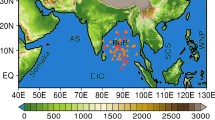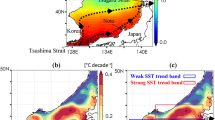Abstract
Using the daily data of temperature from China Meteorological Administration and the NCEP/NCAR reanalysis from 1960 to 2005, we have analyzed the relationships between the summertime high/low temperature events in the middle and lower reaches of the Yangtze River (MLRYR) and the related circulation anomalies in the Eastern Hemisphere. Our results have demonstrated that a significantly increasing trend is observed in daily minimum temperature in the past 50 years. And in some regions in the Northern Hemisphere, the opposite scenarios are observed in circulation anomalies in lower and upper parts of the troposphere in the years when the temperatures are higher than normal, as compared to those in the years when the temperatures are lower than normal in the middle and lower reaches of the Yangtze River (MLRYR). Additionally, the anomalous circulation structure in vertical direction in both the high and lower temperature years are barotropic. It is found that the emergence and maintenance of the aforementioned anomalous circulations are related to three kinds of wave train teleconnection patterns. Further more, influences of the long wave surface radiation on the air temperature are stronger in the nighttime than that in the daytime. While both the maximum and minimum temperatures have negative relationships with the sensible heat flux but positive relationships with the latent heat flux. To some extent, the anomalous dynamic heating (cooling) caused by the vertical thermal advection as well as the diabatic heating (cooling) caused by diabatic processes can explain the formation of the high (low) temperature events in the middle and lower reaches of the Yangtze River (MLRYR) in boreal summer.
Similar content being viewed by others
References
Ambrizzi T, Hoskins B J, 1997. Stationary Rossby-wave propagation in a baroclinic atmosphere. Quarterly Journal of the Royal Meteorological Society, 123: 919–928.
Ambrizzi T, Hoskins B J, Hsu H H, 1995. Rossby wave propagation and teleconnection patterns in the Austral winter. Journal of the Atmospheric Sciences, 52: 3661–3672.
Chen Hongbin, Diao Lijun, 2004. Some extreme events of weather, climate and related phenomena in 2003. Climatic and Environmental Research, 9(1): 218–223. (in Chinese)
Chen Longxun, Zhou Xiuji, Li Weiliang et al., 2004. Characteristics of the climate change and its formation mechanism in China in last 80 years. Acta Meteorologica Sinica, 62(5): 634–646. (in Chinese)
Enomoto T, Hoskins B J, Matsuda Y, 2003. The formation mechanism of the Bonin high in August. Journal of the Meteorological Society of Japan, 129: 157–178.
Gong Daoyi, He Xuezhao, 2002. Interdecadal change in western Pacific subtropical high and climatic effects. Acta Geographica Sinica, 57(2): 185–193. (in Chinese)
Guan Z, Yamagata T, 2003. The unusual summer of 1994 in East Asia: IOD teleconnections. Geophysical Research Letters, 30: 1544, doi: 10.1029/2002GL016831.
Guo Qiyun, Cai Jingning, Shao Xuemei et al., 2003. Interdecadal variability of East-Asian summer monsoon and its impact on the climate of China. Acta Geographica Sinica, 58(4): 569–576. (in Chinese)
Huang Ronghui, Sun Fengying, 1994. Impacts of the thermal state and the convective activities in the tropical western warm pool on the summer climate anomalies in East Asia. Scientia Atmospherica Sinica, 18(2): 141–151. (in Chinese)
Huang R, Wu Y, 1989. The influence of ENSO on the summer climate change in China and its mechanism. Advances in Atmospheric Sciences, 6: 21–32.
IPCC (The Intergovernmental Panel on Climate Change), 2001. Climate Change 2001: The Scientific Basis. In: Houghton J T, Ding Y, Griggs D J (eds.). Cambridge University Press, 881.
IPCC (The Intergovernmental Panel on Climate Change), 2007. Climate Change 2007: The Physical Science Basis. In: Solomon S, Qin D, Manning M (eds.). Cambridge University Press, 996.
Jin Zhifeng, Su Gaoli, Jian Genmei, 2001. The unseasonably cool summer of 1999 and its impacts on the crop growth and development in Zhejiang province. Bulletin of Science and Technology, 17(4): 20–24. (in Chinese)
Jones P D, Raper S C B, Bradley R S, 1986. Northern Hemisphere surface air temperature variations: 1851–1984. Journal of Climate and Applied Meteorology, 25: 161–179.
Kaiser D P, Qian Y, 2002. Decreasing trends in sunshine duration over China for 1954–1998: Indication of increased haze pollution? Geophysical Research Letters, 29: 2042–2045.
Kalnay E, Kanamitsu M, Kistler R et al., 1996. The NCEP/NCAR 40-year reanalysis project. Bulletin of the American Meteorological Society, 77: 437–471.
Karl T R, Kukla G, Razuvayev V N et al., 1991. Global warming: Evidence for asymmetric diurnal temperature change. Geophysical Research Letters, 18: 2253–2256.
Krishnan R, Sugi M, 2001. Baiu rainfall variability and associates monsoon teleconnections. Journal of the Meteorological Society of Japan, 79: 851–860.
Li Q, Liu X, Zhang H et al., 2004. Detecting and adjusting on temporal inhomogeneities in Chinese mean surface air temperature datasets. Advances in Atmospheric Sciences, 21: 260–268.
Liang X, Wang W, 1998. Association between China monsoon rainfall and tropospheric jets. Quarterly Journal of the Royal Meteorological Society, 124: 2597–2623.
Liebmann B, Smith C A, 1996. Description of a complete (interpolated) outgoing longwave radiation dataset. Bulletin of the American Meteorological Society, 77: 1275–1277.
Nitta T, 1987. Convective activities in the tropical western Pacific and their impact on the Northern Hemisphere summer circulation. Journal of the Meteorological Society of Japan, 65: 373–390.
Park C K, Schubert S D, 1997. On the nature of the 1994 East Asian summer drought. Journal of Climate, 10: 1056–1070.
Qin Aimin, Qian Weihong, Cai Qinbo, 2005. Seasonal division and trend characteristic of air temperature in China in the last 41 years. Scientia Meteorologica Sinica, 25(4): 338–345. (in Chinese)
Ren Guoyu, Xu Mingzhi, Chu Ziying et al., 2005. Changes of surface air temperature in China during 1951–2004. Climatic and Environmental Research, 10(4): 717–727. (in Chinese)
Rodwell M J, Hoskins B J, 1996. Monsoons and the dynamics of deserts. Quarterly Journal of the Royal Meteorological Society, 122: 1385–1404.
Sardeshmukh P D, Hoskins B J, 1988. The generation of global rotational flow by steady idealized tropical divergence. Journal of the Atmospheric Sciences, 45: 1228–1251.
Tang Guoli, Lin Xuechun, 1992. Average air temperature series and its variations in China. Meteorological Monthly, 18(7): 3–6. (in Chinese)
Torrence C, Compo G P, 1998. A practical guide to wavelet analysis. Bulletin of the American Meteorological Society, 79: 61–78.
Tu Qipu, Deng Ziwang, Zhou Xiaolan, 2000. Studies on the regional characteristics of air temperature abnormal in China. Acta Meteorologica Sinica, 58(3): 288–296. (in Chinese)
Wakabayashi S, Kawamura R, 2004. Extraction of major teleconnection patterns possibly associated with anomalous summer climate in Japan. Journal of the Meteorological Society of Japan, 82: 1577–1588.
Wang Zunya, Ding Yihui, He Jinhai et al., 2004. An updating analysis of the climate change in China in recent 50 years. Acta Meteorologica Sinica, 62(2): 228–236. (in Chinese)
Wei Fengying, Cao Hongxing, Wang Liping, 2003. Climatic warming process during 1980s–1990s in China. Journal of Applied Meteorological Science, 14(1): 79–86. (in Chinese)
Zhai Panmao, Ren Fumin, 1997. On changes of China’s maximum and minimum temperatures in the recent 40 years. Acta Meteorologica Sinica, 55(4): 418–429. (in Chinese)
Zhang Qiong, Wu Guoxiong, 2001. The large area flood and drought over Yangtze River Valley and its relation to the South Asia high. Acta Meteorologica Sinica, 59(5): 569–577. (in Chinese)
Zhang R, Sumi A, Kimoto M, 1996. Impact of El Nino on the East Asian monsoon: A diagnostic study of the’ 86/87 and’ 91/92 events. Journal of the Meteorological Society of Japan, 74: 49–62.
Zhang R, Sumi A, Kimoto M, 1999. A diagnostic study of the impact of El Nino on the precipitation in China. Advances in Atmospheric Sciences, 16: 229–241.
Zhao Zongci, Wang Shaowu, Xu Ying et al., 2005. Attribution of the 20th century climate warming in China. Climatic and Environmental Research, 10(4): 808–817. (in Chinese)
Zhou Liantong, Huang Ronghui, 2003. Research on the characteristics of interdecadal variability of summer climate in China and its possible cause. Climatic and Environmental Research, 8(3): 274–290. (in Chinese)
Author information
Authors and Affiliations
Corresponding author
Additional information
Foundation: The key technology R&D program of China, No.2007BAC29B02; Project of Jiangsu Key Laboratory of Meteorological Disaster, No.KLME060101
Author: Cai Jiaxi (1982–), Ph.D Candidate, specialized in climate dynamics.
Rights and permissions
About this article
Cite this article
Cai, J., Guan, Z., Gao, Q. et al. Summertime temperature variations in the middle and lower reaches of Yangtze River and their related circulation anomalies in the past five decades. J. Geogr. Sci. 20, 581–598 (2010). https://doi.org/10.1007/s11442-010-0581-3
Received:
Accepted:
Published:
Issue Date:
DOI: https://doi.org/10.1007/s11442-010-0581-3




